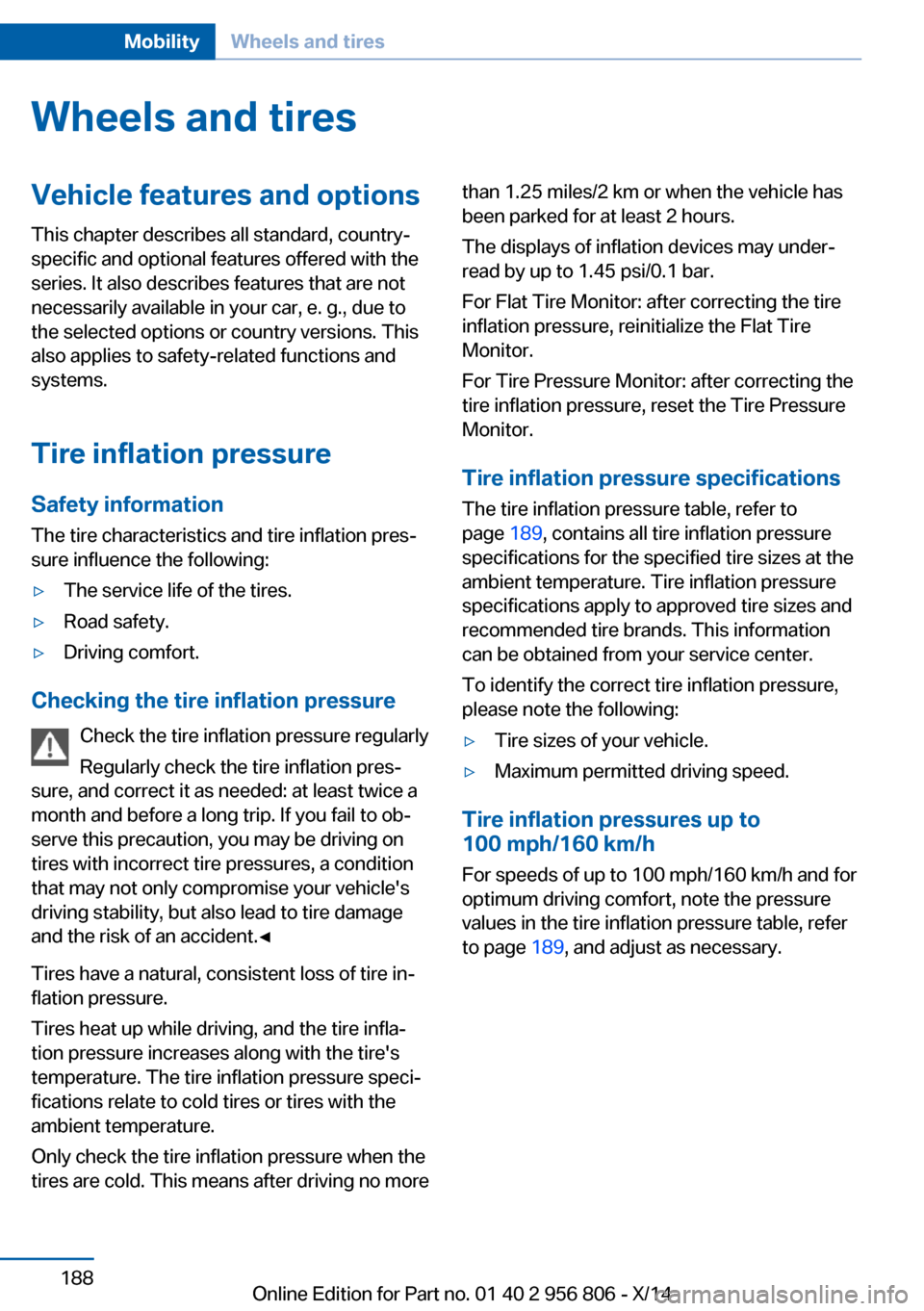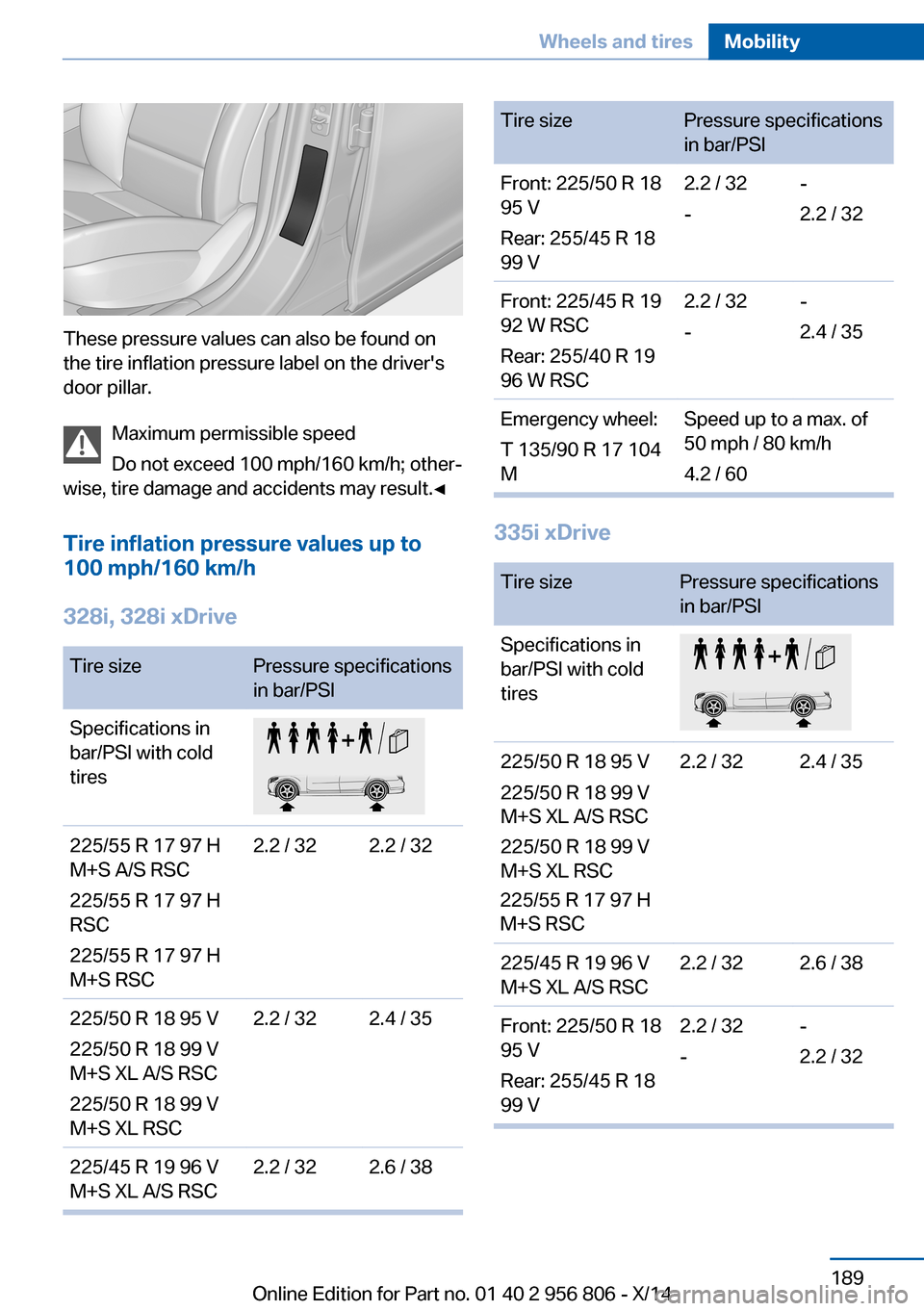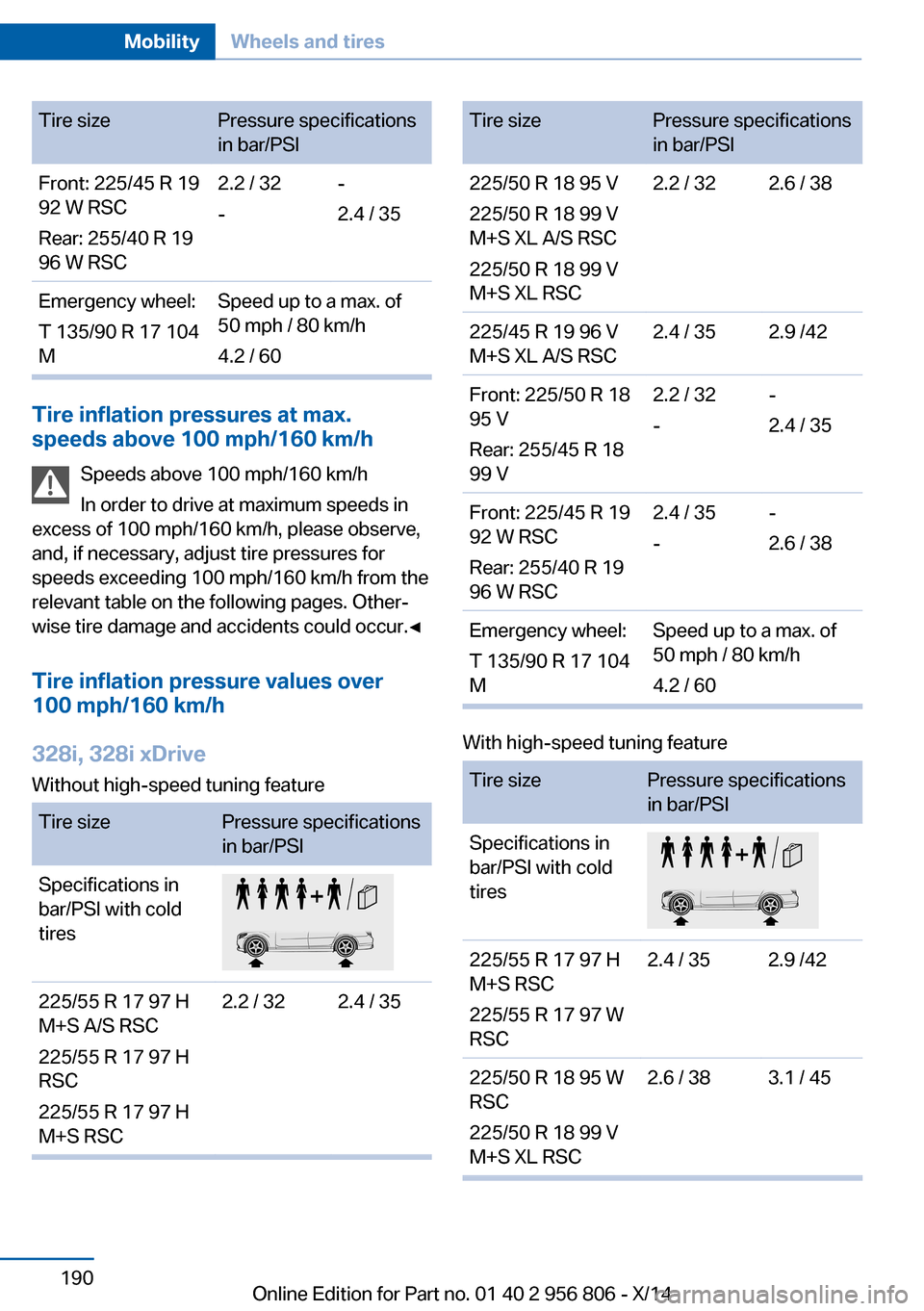2014 BMW 3 SERIES GRAN COUPE inflation pressure
[x] Cancel search: inflation pressurePage 175 of 246

LoadingVehicle features and options
This chapter describes all standard, country-
specific and optional features offered with the
series. It also describes features that are not
necessarily available in your car, e. g., due to
the selected options or country versions. This
also applies to safety-related functions and
systems.
Hints Overloading the vehicle
To avoid exceeding the approved ca‐
pacity of the tires, never overload the vehicle.
Overloading can lead to overheating and in‐
creases the rate at which damage develops in‐
side the tires. This could result in a sudden
loss of tire inflation pressure.◀
No fluids in the cargo area
Make sure that fluids do not leak into the
cargo area; otherwise, the vehicle may be dam‐
aged.◀
Heavy and hard objects
Do not stow any heavy and hard objects
in the car's interior without securing them; oth‐
erwise, they may present a danger to occu‐
pants, e.g., during braking and evasive maneu‐
vers.◀
Determining the load limit1.Locate the following statement on your ve‐
hicle’s placard:▷The combined weight of occupants
and cargo should never exceed XXX kg
or YYY lbs. Otherwise, damage to thevehicle and unstable driving situations
may result.2.Determine the combined weight of the
driver and passengers that will be riding in
your vehicle.3.Subtract the combined weight of the driver
and passengers from XXX kilograms or
YYY pounds.4.The resulting figure equals the available
amount of cargo and luggage load ca‐
pacity.
For example, if the YYY amount equals
1,000 lbs and there will be four 150 lbs
passengers in your vehicle, the amount of
available cargo and luggage load capacity
is 400 lbs: 1,000 lbs minus 600 lbs =
400 lbs.5.Determine the combined weight of lug‐
gage and cargo being loaded on the vehi‐
cle. That weight may not safely exceed the
available cargo and luggage load capacity
calculated in Step 4.Seite 171LoadingDriving tips171
Online Edition for Part no. 01 40 2 956 806 - X/14
Page 178 of 246

Saving fuelVehicle features and optionsThis chapter describes all standard, country-
specific and optional features offered with the
series. It also describes features that are not
necessarily available in your car, e. g., due to
the selected options or country versions. This
also applies to safety-related functions and
systems.
General information
Your vehicle contains advanced technology for
the reduction of fuel consumption and emis‐
sions.
Fuel consumption depends on a number of dif‐
ferent factors.
Carrying out certain measures, such as a mod‐
erate driving style and regular maintenance,
can influence fuel consumption and the envi‐
ronmental impact.
Remove unnecessary cargoAdditional weight increases fuel consumption.
Remove attached parts
following use
Remove auxiliary mirrors, roof or rear luggage
racks which are no longer required following
use.
Attached parts on the vehicle impair the aero‐
dynamics and increase the fuel consumption.Close the windows and glass
sunroof
Driving with the glass sunroof and windows
open results in increased air resistance and
thereby reduces the range.
Tires
General information Tires can affect fuel consumption in various
ways, e.g., tire size may influence fuel con‐
sumption.
Check the tire inflation pressure
regularly
Check and, if needed, correct the tire inflation
pressure at least twice a month and before
starting on a long trip.
Low tire inflation pressure increases rolling re‐
sistance and thus raises fuel consumption and
tire wear.
Drive away immediately
Do not wait for the engine to warm-up while
the vehicle remains stationary. Start driving
right away, but at moderate engine speeds.
This is the quickest way of warming the cold
engine up to operating temperature.
Look well ahead when
driving
Avoid unnecessary acceleration and braking.
By maintaining a suitable distance to the vehi‐
cle driving ahead of you.
Driving smoothly and proactively reduces fuel
consumption.Seite 174Driving tipsSaving fuel174
Online Edition for Part no. 01 40 2 956 806 - X/14
Page 192 of 246

Wheels and tiresVehicle features and options
This chapter describes all standard, country-
specific and optional features offered with the
series. It also describes features that are not
necessarily available in your car, e. g., due to
the selected options or country versions. This
also applies to safety-related functions and
systems.
Tire inflation pressure
Safety information
The tire characteristics and tire inflation pres‐
sure influence the following:▷The service life of the tires.▷Road safety.▷Driving comfort.
Checking the tire inflation pressure
Check the tire inflation pressure regularly
Regularly check the tire inflation pres‐
sure, and correct it as needed: at least twice a
month and before a long trip. If you fail to ob‐
serve this precaution, you may be driving on
tires with incorrect tire pressures, a condition
that may not only compromise your vehicle's
driving stability, but also lead to tire damage
and the risk of an accident.◀
Tires have a natural, consistent loss of tire in‐
flation pressure.
Tires heat up while driving, and the tire infla‐
tion pressure increases along with the tire's
temperature. The tire inflation pressure speci‐
fications relate to cold tires or tires with the
ambient temperature.
Only check the tire inflation pressure when the
tires are cold. This means after driving no more
than 1.25 miles/2 km or when the vehicle has
been parked for at least 2 hours.
The displays of inflation devices may under-
read by up to 1.45 psi/0.1 bar.
For Flat Tire Monitor: after correcting the tire
inflation pressure, reinitialize the Flat Tire
Monitor.
For Tire Pressure Monitor: after correcting the
tire inflation pressure, reset the Tire Pressure
Monitor.
Tire inflation pressure specifications
The tire inflation pressure table, refer to
page 189, contains all tire inflation pressure
specifications for the specified tire sizes at the
ambient temperature. Tire inflation pressure
specifications apply to approved tire sizes and
recommended tire brands. This information
can be obtained from your service center.
To identify the correct tire inflation pressure,
please note the following:▷Tire sizes of your vehicle.▷Maximum permitted driving speed.
Tire inflation pressures up to
100 mph/160 km/h
For speeds of up to 100 mph/160 km/h and for
optimum driving comfort, note the pressure
values in the tire inflation pressure table, refer
to page 189, and adjust as necessary.
Seite 188MobilityWheels and tires188
Online Edition for Part no. 01 40 2 956 806 - X/14
Page 193 of 246

Seite 189Wheels and tiresMobility189
Online Edition for Part no. 01 40 2 956 806 - X/14
These pressure values can also be found on
the tire inflation pressure label on the driver's
door pillar.
Maximum permissible speed
Do not exceed 100 mph/160 km/h; other‐
wise, tire damage and accidents may result.◀
Tire inflation pressure values up to
100 mph/160 km/h
328i, 328i xDrive
Tire sizePressure specifications
in bar/PSI
Specifications in
bar/PSI with cold
tires
225/55 R 17 97 H
M+S A/S RSC
225/55 R 17 97 H
RSC
225/55 R 17 97 H
M+S RSC
2.2 / 32 2.2 / 32
225/50 R 18 95 V
225/50 R 18 99 V
M+S XL A/S RSC
225/50 R 18 99 V
M+S XL RSC
2.2 / 32 2.4 / 35
225/45 R 19 96 V
M+S XL A/S RSC
2.2 / 32 2.6 / 38
Tire sizePressure specifications
in bar/PSI
Front: 225/50 R 18
95 V
Rear: 255/45 R 18
99 V
2.2 / 32
-
-
2.2 / 32
Front: 225/45 R 19
92 W RSC
Rear: 255/40 R 19
96 W RSC
2.2 / 32
-
-
2.4 / 35
Emergency wheel:
T 135/90 R 17 104
M
Speed up to a max. of
50 mph / 80 km/h
4.2 / 60
335i xDrive
Tire sizePressure specifications
in bar/PSI
Specifications in
bar/PSI with cold
tires
225/50 R 18 95 V
225/50 R 18 99 V
M+S XL A/S RSC
225/50 R 18 99 V
M+S XL RSC
2.2 / 32 2.4 / 35
225/45 R 19 96 V
M+S XL A/S RSC
2.2 / 32 2.6 / 38
Front: 225/50 R 18
95 V
Rear: 255/45 R 18
99 V
2.2 / 32
-
-
2.2 / 32
225/55 R 17 97 H
M+S RSC
Page 194 of 246

Seite 190MobilityWheels and tires190
Online Edition for Part no. 01 40 2 956 806 - X/14
Tire sizePressure specifications
in bar/PSI
Front: 225/45 R 19
92 W RSC
Rear: 255/40 R 19
96 W RSC
2.2 / 32
-
-
2.4 / 35
Emergency wheel:
T 135/90 R 17 104
M
Speed up to a max. of
50 mph / 80 km/h
4.2 / 60
Tire inflation pressures at max.
speeds above 100 mph/160 km/h
Speeds above 100 mph/160 km/h
In order to drive at maximum speeds in
excess of 100 mph/160 km/h, please observe,
and, if necessary, adjust tire pressures for
speeds exceeding 100 mph/160 km/h from the
relevant table on the following pages. Other‐
wise tire damage and accidents could occur.◀
Tire inflation pressure values over
100 mph/160 km/h
328i, 328i xDrive
Without high-speed tuning feature
Tire sizePressure specifications
in bar/PSI
Specifications in
bar/PSI with cold
tires
225/55 R 17 97 H
M+S A/S RSC
225/55 R 17 97 H
RSC
225/55 R 17 97 H
M+S RSC
2.2 / 322.4 / 35Tire sizePressure specifications
in bar/PSI
225/50 R 18 95 V
225/50 R 18 99 V
M+S XL A/S RSC
225/50 R 18 99 V
M+S XL RSC
2.2 / 322.6 / 38225/45 R 19 96 V
M+S XL A/S RSC
2.4 / 352.9 /42Front: 225/50 R 18
95 V
Rear: 255/45 R 18
99 V
2.2 / 32
-
-
2.4 / 35
Front: 225/45 R 19
92 W RSC
Rear: 255/40 R 19
96 W RSC
2.4 / 35
-
-
2.6 / 38
Emergency wheel:
T 135/90 R 17 104
M
Speed up to a max. of
50 mph / 80 km/h
4.2 / 60
With high-speed tuning feature
Tire sizePressure specifications
in bar/PSI
Specifications in
bar/PSI with cold
tires
225/55 R 17 97 H
M+S RSC
225/55 R 17 97 W
RSC
2.4 / 352.9 /42225/50 R 18 95 W
RSC
225/50 R 18 99 V
M+S XL RSC
2.6 / 383.1 / 45
Page 199 of 246

Retreaded tires
Possibly substantial variations in the de‐
sign and age of the tire casing structures can
limit service life and have a negative impact on
road safety.◀
Winter tires
Winter tires are recommended for operating on
winter roads.
Although so-called all-season M+S tires pro‐
vide better winter traction than summer tires, they do not provide the same level of perform‐
ance as winter tires.
Maximum speed of winter tires If the maximum speed of the vehicle is higher
than the permissible speed for the winter tires,
then a respective symbol is displayed in your
field of vision. You can obtain this sign from the
tire specialist or from your service center.
Maximum speed for winter tires
Do not exceed the maximum speed for
the respective winter tires; otherwise, tire dam‐
age and accidents can occur.◀
Run-flat tires If you are already using run-flat tires, for your
own safety you should replace them only with
the same kind. No spare tire is available in the
case of a flat tire. Your service center will be
glad to advise you.
Rotating wheels between axlesDifferent wear patterns can occur on the frontand rear axles depending on individual driving
conditions. The tires can be rotated between
the axles to achieve even wear. Your service
center will be glad to advise you. After rotating,
check the tire pressure and correct if needed.
Rotating the tires is not permissible on vehi‐
cles with different tire sizes on the front and
rear axles, i.e. when using different types of
tires.Storage
Store wheels and tires in a cool, dry place with
as little exposure to light as possible.
Always protect tires against all contact with oil,
grease and fuels.
Do not exceed the maximum tire inflation pres‐
sure indicated on the side wall of the tire.
Run-flat tires Label
RSC label on the tire sidewall.
The wheels consist of tires that are self-sup‐
porting, to a limited degree, and possibly spe‐
cial rims.
The support of the sidewall allows the tire to
remain drivable to a restricted degree in the
event of a tire inflation pressure loss.
Follow the instructions for continued driving
with a flat tire.
Changing run-flat tires
For your own safety, only use run-flat tires. No
spare tire is available in the case of a flat tire.
Your service center will be glad to advise you.
Snow chains
Fine-link snow chains
Only certain types of fine-link snow chains
have been tested by the manufacturer of the
vehicle, classified as road-safe and approved.
Seite 195Wheels and tiresMobility195
Online Edition for Part no. 01 40 2 956 806 - X/14
Page 240 of 246

Horn 14
Hot exhaust system 168
HUD Head-up Display 89
Hydroplaning 169
I Ice warning, see External temperature warning 81
Icy roads, see External tem‐ perature warning 81
Identification marks, tires 191
Identification number, see ve‐ hicle identification num‐
ber 9
iDrive 18
Ignition key, refer to Remote control 34
Ignition off 64
Ignition on 64
Indication of a flat tire 100 , 103
Indicator and alarm lamps, see Check Control 77
Indicator lamp, see Check Control 77
Individual air distribu‐ tion 147, 150
Individual settings, refer to Personal Profile 35
Inflation pressure, tires 188
Inflation pressure warning FTM, tires 103
Info display, refer to Com‐ puter 85
Initialize, Tire Pressure Moni‐ tor TPM 100
Initializing, Flat Tire Monitor FTM 103
Instrument cluster 76
Instrument cluster, electronic displays 76
Instrument lighting 94
Integrated key 34
Integrated Owner's Manual in the vehicle 29 Intelligent Emergency Re‐
quest 216
Intelligent Safety 104
Intensity, AUTO pro‐ gram 149
Interior equipment 153
Interior lights 94
Interior lights via remote con‐ trol 37
Interior motion sensor 46
Interior rearview mirror, auto‐ matic dimming feature 58
Interior rearview mirror, com‐ pass 155
Interior rearview mirror, man‐ ually dimmable 58
Interval display, service re‐ quirements 82
J Jacking points for the vehicle jack 213
Joystick, Steptronic transmis‐ sion 72
Jump-starting 217
K
Key/remote control 34
Keyless Go, refer to Comfort Access 41
Key Memory, refer to Per‐ sonal Profile 35
Kickdown, Steptronic trans‐ mission 72
Knee airbag 97
L Lamp replacement 205
Lamp replacement, front 206
Lamp replacement, rear 211
Lane departure warning 113
Lane margin, warning 113 Language on Control Dis‐
play 88
Lashing eyes, securing cargo 172
LATCH child restraint sys‐ tem 62
Launch Control 74
Leather, care 222
LEDs, light-emitting di‐ odes 206
Length, vehicle 228
Letters and numbers, enter‐ ing 25
Light alloy wheels, care 223
Light control 92
Light-emitting diodes, LEDs 206
Lighter 157
Lighting 91
Lighting via remote con‐ trol 37
Light reel 91
Lights 91
Lights and bulbs 205
Load 172
Loading 171
Loading position 161
Lock, door 38
Locking/unlocking via door lock 38
Locking/unlocking with re‐ mote control 37
Locking, automatic 44
Locking, settings 44
Lock, power window 47
Locks, doors, and win‐ dows 63
Low beams 91
Low beams, automatic, refer to High-beam Assistant 93
Lower back support 52
Luggage rack, see Roof- mounted luggage rack 173
Lumbar support 52 Seite 236ReferenceEverything from A to Z236
Online Edition for Part no. 01 40 2 956 806 - X/14
Page 243 of 246

Service requirements, Condi‐tion Based Service
CBS 203
Service requirements, dis‐ play 82
Service, Roadside Assis‐ tance 217
Services, ConnectedDrive
Servotronic 124
SET button, see Active Cruise Control, ACC 125
SET button, see Cruise con‐ trol 131
Settings, locking/unlock‐ ing 44
Settings on Control Dis‐ play 88
Settings, storing for seat, mir‐ ror 56
Shift paddles on steering wheel 73
Side airbags 96
Side View 138
Signaling, horn 14
Signals when unlocking 44
Sitting safely 50
Size 228
Slide/tilt glass roof 47
Smallest turning radius 228
Snow chains 195
Socket 157
Socket, OBD Onboard Diag‐ nostics 203
SOS button 216
Spare fuse 214
Specified engine oil types 201
Speed, average 86
Speed limit detection, com‐ puter 86
Speed limiter, display 83
Speed Limit Information 83
Speed warning 87
Split screen 23
SPORT+ - program, Dynamic Driving Control 122 Sport displays, torque dis‐
play, performance dis‐
play 87
SPORT program, Dynamic Driving Control 122
Sport program, transmis‐ sion 73
Sport steering, variable 120
Stability control systems 118
Start/stop, automatic func‐ tion 66
Start/Stop button 64
Start function during malfunc‐ tion 35
Starting the engine 65
Status control display, tires 100
Status information, iDrive 23
Status of Owner's Manual 6
Steering assistance 124
Steering wheel, adjusting 59
Steering wheel heating 59
Steptronic Sport transmis‐ sion 73
Steptronic transmission 72
Stopping the engine 65
Storage compartment in the rear 164
Storage compartments 162
Storage compartments, loca‐ tions 162
Storage, tires 195
Storing the vehicle 224
Summer tires, tread 193
Sun visor 157
Supplementary text mes‐ sage 80
Surround View 136
Switch for Dynamic Driv‐ ing 121
Switch-on times, parked-car ventilation 152
Switch, refer to Cockpit 14
Symbols 6
Symbols in the status field 23 T
Tachometer 80
Tailgate, automatic 39
Tailgate, closing with no- touch activation 42
Tailgate, Emergency unlock‐ ing 41
Tailgate, opening with no- touch activation 42
Tailgate via remote con‐ trol 37
Tail lights 211
Technical changes, refer to Safety 7
Technical data 228
Telephone, see user's manual for Navigation, Entertain‐
ment and Communication
Temperature, automatic cli‐ mate control 147, 149
Temperature display for ex‐ ternal temperature 81
Temperature, engine oil 80
Tempomat, refer to Active Cruise Control 125
Terminal, starting aid 218
Text message, supplemen‐ tary 80
Theft alarm system, refer to Alarm system 45
Thigh support 52
Tilt alarm sensor 46
Time of arrival 86
Tire damage 193
Tire identification marks 191
Tire inflation pressure 188
Tire inflation pressure moni‐ tor, refer to FTM 103
Tire Pressure Monitor TPM 99
Tires, changing 194
Tires, everything on wheels and tires 188
Tires, run-flat tires 195
Tire tread 193 Seite 239Everything from A to ZReference239
Online Edition for Part no. 01 40 2 956 806 - X/14